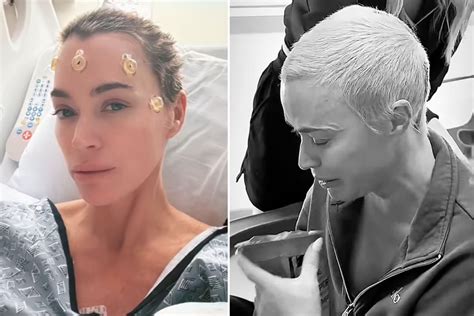
Teddi Mellencamp Arroyave is undergoing further medical testing to determine the cause of persistent headaches, offering a health update to her followers after initial concerns arose about her well-being. The reality television personality, known for her role on “The Real Housewives of Beverly Hills,” shared her experience and ongoing investigation into her condition, emphasizing the importance of proactive health monitoring.
Arroyave, 42, initially took to social media to express concerns about a severe headache that prompted her to seek medical attention. Since then, she has been transparent with her followers, providing updates as she navigates the diagnostic process. This openness reflects a trend among public figures who use their platforms to raise awareness about health issues and encourage others to prioritize their well-being.
The reality star’s health journey began with a visit to medical professionals after experiencing debilitating headaches. Following an initial assessment, doctors recommended further testing to rule out potential underlying causes. Arroyave’s decision to share her experience publicly has resonated with many, highlighting the often-complex process of diagnosing and treating medical conditions.
“I am currently undergoing testing to determine the cause of these headaches,” Mellencamp stated in her recent social media update. “I want to thank everyone for their well wishes and support. It means the world to me.” She emphasized the importance of listening to one’s body and seeking medical attention when necessary.
Arroyave’s medical journey unfolds amid a backdrop of increasing public awareness of neurological conditions and the challenges associated with diagnosis and treatment. Headaches, which are a common ailment, can sometimes be indicative of more serious underlying issues. Medical professionals emphasize the need for thorough evaluation when headaches are persistent, severe, or accompanied by other concerning symptoms.
In addition to her personal health concerns, Teddi Mellencamp Arroyave has been involved in various health and wellness initiatives, further underscoring her commitment to promoting healthy living. Her public advocacy and willingness to share her personal experiences have made her a notable figure in discussions surrounding health and wellness.
As Arroyave awaits further test results, her story serves as a reminder of the importance of regular medical check-ups and proactive health management. She has urged her followers to prioritize their health and seek medical attention promptly if they experience any concerning symptoms.
The former “Real Housewives” star’s candor comes after several health experiences she has shared publicly, including her battles with melanoma. In March 2022, she revealed she had been diagnosed with melanoma after her friend and fellow “Real Housewives” star, Kyle Richards, urged her to get a mole checked out by a doctor.
“I went in, and it was melanoma,” Mellencamp explained at the time. “I feel good, but I have to go back in three months for another check.”
In October 2022, Mellencamp announced that she had been diagnosed with melanoma for a second time. She shared a photo of a bandage on her shoulder and wrote, “Melanoma round two.” She expressed gratitude to her doctors and urged her followers to get regular skin checks.
“Grateful for my doctors and the amazing team at USC,” she wrote. “Please get your skin checked!”
These experiences have shaped her perspective on health and wellness, driving her to become an advocate for early detection and preventative care. Her willingness to share her struggles has helped to raise awareness about the importance of skin checks and other preventative measures.
Teddi Mellencamp’s health journey is not only a personal one, but it also resonates with a broader audience that appreciates her transparency and commitment to promoting health awareness. As she continues to undergo testing and await results, her story serves as a reminder of the importance of prioritizing one’s health and seeking medical attention when necessary.
In-Depth Analysis and Background
Teddi Mellencamp Arroyave’s recent health update regarding her persistent headaches has brought attention to the broader topic of neurological health and the diagnostic challenges associated with identifying the underlying causes of such symptoms. Headaches are a common ailment, affecting a significant portion of the population, but their origins can vary widely, ranging from benign tension headaches to more serious conditions requiring immediate medical intervention.
The prevalence of headaches underscores the importance of understanding the different types of headaches, their potential causes, and the diagnostic approaches used to identify the root of the problem. According to the World Health Organization (WHO), nearly half of all adults worldwide experience headaches, with migraine and tension-type headaches being the most common. While most headaches are not indicative of serious underlying conditions, persistent or severe headaches, especially when accompanied by other neurological symptoms, warrant a thorough medical evaluation.
Arroyave’s decision to seek medical attention for her headaches reflects the recommendations of medical professionals who advise individuals to consult with a healthcare provider if they experience any of the following:
- Sudden onset of severe headache
- Headache accompanied by fever, stiff neck, rash, confusion, seizures, double vision, weakness, numbness, or speaking difficulties
- Headache following a head injury
- Chronic headaches that worsen over time
- Headaches that interfere with daily activities
The diagnostic process for headaches typically involves a comprehensive medical history, a physical examination, and potentially neurological testing. The medical history includes details about the characteristics of the headaches, such as their frequency, duration, intensity, and location, as well as any associated symptoms and potential triggers. The physical examination may involve checking vital signs, assessing neurological function, and examining the head and neck for any signs of underlying issues.
In some cases, further neurological testing may be necessary to rule out potential causes such as brain tumors, aneurysms, or infections. These tests may include:
- Magnetic Resonance Imaging (MRI): An MRI scan uses magnetic fields and radio waves to create detailed images of the brain and surrounding structures.
- Computed Tomography (CT) Scan: A CT scan uses X-rays to create cross-sectional images of the brain.
- Electroencephalogram (EEG): An EEG measures the electrical activity of the brain.
- Lumbar Puncture (Spinal Tap): A lumbar puncture involves collecting a sample of cerebrospinal fluid to check for infection or other abnormalities.
The process of diagnosing the cause of headaches can be complex and time-consuming, often requiring multiple consultations with specialists and a series of diagnostic tests. Arroyave’s experience highlights the importance of patience and persistence in navigating the medical system and advocating for one’s health.
Moreover, Teddi Mellencamp’s openness about her previous melanoma diagnoses underscores the importance of skin cancer awareness and prevention. Melanoma, the most serious type of skin cancer, can be life-threatening if not detected and treated early. According to the American Academy of Dermatology, melanoma accounts for a small percentage of skin cancer cases but causes the majority of skin cancer deaths.
Risk factors for melanoma include:
- Exposure to ultraviolet (UV) radiation from sunlight or tanning beds
- Fair skin, freckles, and light hair
- A family history of melanoma
- A large number of moles
- A history of sunburns
The American Academy of Dermatology recommends the following steps to prevent skin cancer:
- Seek shade, especially during the sun’s peak hours (10 a.m. to 4 p.m.).
- Wear protective clothing, such as long sleeves, pants, a wide-brimmed hat, and sunglasses.
- Use sunscreen with an SPF of 30 or higher and reapply every two hours, or more often if swimming or sweating.
- Avoid tanning beds and sun lamps.
- Examine your skin regularly for any new or changing moles or spots.
- See a dermatologist for regular skin exams, especially if you have risk factors for skin cancer.
Teddi Mellencamp’s advocacy for skin cancer awareness and prevention serves as a valuable reminder of the importance of protecting one’s skin and seeking regular skin checks from a dermatologist. Her willingness to share her personal experiences has helped to raise awareness about the importance of early detection and preventative care.
Expanded Context and Additional Details
The realm of reality television often provides a platform for personalities to connect with a broad audience, sharing aspects of their lives that resonate with viewers. When these public figures choose to be transparent about their health challenges, it can have a significant impact on public awareness and understanding. Teddi Mellencamp’s decision to share her health journey with her followers is a prime example of this phenomenon.
By openly discussing her headaches and the diagnostic process she is undergoing, Arroyave is not only informing her audience but also potentially encouraging others to prioritize their health and seek medical attention when necessary. This type of advocacy can be particularly effective because it comes from a relatable source, someone who is perceived as being authentic and genuine.
Moreover, Arroyave’s previous experiences with melanoma have likely shaped her perspective on health and wellness, driving her to become an advocate for early detection and preventative care. Her willingness to share her struggles has helped to raise awareness about the importance of skin checks and other preventative measures.
The broader context of health awareness in the digital age is also relevant to Arroyave’s situation. Social media platforms have become increasingly important sources of health information, with many individuals turning to online communities for support and guidance. While these platforms can be valuable resources, it is important to approach online health information with caution and to consult with qualified healthcare professionals for accurate diagnoses and treatment plans.
Teddi Mellencamp’s health journey also highlights the importance of mental health in overall well-being. Chronic pain and uncertainty about one’s health can take a toll on mental health, leading to anxiety, depression, and other emotional challenges. It is important for individuals facing health challenges to seek support from mental health professionals and to prioritize self-care activities that promote emotional well-being.
In addition to her personal health concerns, Teddi Mellencamp Arroyave has been involved in various health and wellness initiatives, further underscoring her commitment to promoting healthy living. Her public advocacy and willingness to share her personal experiences have made her a notable figure in discussions surrounding health and wellness.
As Arroyave awaits further test results, her story serves as a reminder of the importance of regular medical check-ups and proactive health management. She has urged her followers to prioritize their health and seek medical attention promptly if they experience any concerning symptoms.
Expert Opinions and Medical Perspectives
To provide a more comprehensive understanding of the issues raised by Teddi Mellencamp Arroyave’s health update, it is valuable to incorporate expert opinions and medical perspectives on headaches, melanoma, and the importance of proactive health management.
Dr. Jennifer Kriegler, a neurologist specializing in headache disorders, emphasizes the importance of seeking medical attention for persistent or severe headaches. “Headaches are a common symptom, but they can sometimes be indicative of more serious underlying conditions,” Dr. Kriegler explains. “It is important to consult with a healthcare provider if you experience sudden onset of severe headache, headache accompanied by fever or other neurological symptoms, or chronic headaches that worsen over time.”
Dr. Kriegler also highlights the importance of a thorough medical evaluation to determine the cause of headaches. “The diagnostic process typically involves a comprehensive medical history, a physical examination, and potentially neurological testing, such as MRI or CT scan,” she says. “The goal is to identify any underlying causes that may be contributing to the headaches and to develop an appropriate treatment plan.”
Regarding melanoma, Dr. Susan Swetter, a dermatologist specializing in skin cancer, emphasizes the importance of early detection and preventative care. “Melanoma is the most serious type of skin cancer, but it is highly treatable if detected early,” Dr. Swetter explains. “The key to early detection is to examine your skin regularly for any new or changing moles or spots and to see a dermatologist for regular skin exams, especially if you have risk factors for skin cancer.”
Dr. Swetter also recommends taking steps to protect one’s skin from UV radiation, such as seeking shade, wearing protective clothing, and using sunscreen with an SPF of 30 or higher. “Sunscreen is an important tool for protecting your skin, but it is not a substitute for other preventative measures,” she says. “It is important to use sunscreen correctly, applying it liberally and reapplying every two hours, or more often if swimming or sweating.”
In addition to seeking medical care and taking preventative measures, experts emphasize the importance of maintaining a healthy lifestyle to support overall health and well-being. This includes eating a balanced diet, getting regular exercise, managing stress, and getting enough sleep.
“A healthy lifestyle can help to reduce your risk of developing many chronic diseases, including headaches and skin cancer,” explains Dr. Michael Roizen, a physician specializing in preventative medicine. “By taking care of your body, you can improve your overall health and quality of life.”
Frequently Asked Questions (FAQ)
-
What prompted Teddi Mellencamp to seek medical attention?
- Teddi Mellencamp sought medical attention due to persistent and concerning headaches. She shared that these headaches prompted her to undergo further testing to determine the underlying cause.
-
What kind of health issues has Teddi Mellencamp previously faced?
- Teddi Mellencamp has previously been diagnosed with melanoma twice. She has been open about her experiences, advocating for regular skin checks and sun protection.
-
What tests is Teddi Mellencamp currently undergoing?
- Teddi Mellencamp is currently undergoing neurological testing to determine the cause of her headaches. The specifics of these tests have not been disclosed, but they likely include imaging scans like MRI or CT scans to examine her brain.
-
Why is Teddi Mellencamp sharing her health journey publicly?
- Teddi Mellencamp is sharing her health journey to raise awareness about the importance of proactive health monitoring and seeking medical attention when necessary. Her openness aims to encourage others to prioritize their health.
-
What advice has Teddi Mellencamp given to her followers regarding health?
- Teddi Mellencamp has urged her followers to listen to their bodies and seek medical attention promptly if they experience any concerning symptoms. She emphasizes the importance of regular medical check-ups and preventative care.
-
What are the common types of headaches and what are their symptoms?
- The most common types of headaches include tension headaches, migraines, and cluster headaches. Tension headaches typically cause mild to moderate pain that feels like a tight band around the head. Migraines are characterized by severe throbbing pain, often accompanied by nausea, vomiting, and sensitivity to light and sound. Cluster headaches cause intense pain around one eye or temple, often with nasal congestion or a runny nose.
-
When should someone seek medical attention for a headache?
- Seek immediate medical attention for a headache if it is sudden and severe, accompanied by fever, stiff neck, confusion, seizures, vision changes, weakness, numbness, or difficulty speaking. Also, consult a doctor if headaches are frequent, persistent, or worsening, or if they interfere with daily activities.
-
What are the risk factors for melanoma?
- Risk factors for melanoma include exposure to ultraviolet (UV) radiation from sunlight or tanning beds, fair skin, freckles, and light hair, a family history of melanoma, a large number of moles, and a history of sunburns.
-
What are the key steps for skin cancer prevention?
- The key steps for skin cancer prevention include seeking shade during peak sun hours, wearing protective clothing such as long sleeves, pants, and a wide-brimmed hat, using sunscreen with an SPF of 30 or higher and reapplying every two hours, avoiding tanning beds and sun lamps, and examining your skin regularly for any new or changing moles or spots.
-
How can a healthy lifestyle contribute to overall well-being, especially regarding headaches and skin cancer?
- A healthy lifestyle, including a balanced diet, regular exercise, stress management, and adequate sleep, can help reduce the risk of developing chronic diseases, including headaches and skin cancer. It can also improve overall health and quality of life by strengthening the immune system and promoting cellular repair.
-
What specific neurological tests are commonly used to diagnose the cause of persistent headaches?
Common neurological tests used to diagnose the cause of persistent headaches include:
- Magnetic Resonance Imaging (MRI): Provides detailed images of the brain to detect tumors, aneurysms, or other abnormalities.
- Computed Tomography (CT) Scan: Uses X-rays to create cross-sectional images of the brain, identifying structural issues.
- Electroencephalogram (EEG): Measures electrical activity in the brain, helping to diagnose seizure disorders or other neurological conditions.
- Lumbar Puncture (Spinal Tap): Collects cerebrospinal fluid to check for infections or abnormalities in the brain and spinal cord.
- What are some potential underlying conditions that can cause persistent headaches?
Persistent headaches can be caused by various underlying conditions, including:
- Tension Headaches: Often related to stress and muscle tension.
- Migraines: Can be triggered by hormonal changes, stress, or certain foods and drinks.
- Cluster Headaches: Severe headaches that occur in clusters, often with intense pain around one eye.
- Sinus Headaches: Related to sinus infections or inflammation.
- Cervicogenic Headaches: Caused by problems in the neck, such as muscle strain or joint dysfunction.
- Brain Tumors: Growths in the brain that can cause persistent headaches.
- Aneurysms: Bulges in blood vessels that can cause severe headaches if they rupture.
- Infections: Meningitis or encephalitis can cause severe headaches.
- How has social media impacted the way people share and receive health information?
Social media has significantly changed how people share and receive health information by:
- Increasing Accessibility: Making health information more readily available to a wider audience.
- Facilitating Support Networks: Creating online communities where individuals can share experiences and find support.
- Raising Awareness: Allowing public figures to share their health journeys, raising awareness about various conditions.
- Spreading Misinformation: Also posing a risk of spreading inaccurate or misleading health information.
- What role do public figures play in raising awareness about health issues?
Public figures play a crucial role in raising awareness about health issues by:
- Sharing Personal Stories: Making health conditions more relatable and understandable.
- Encouraging Preventative Measures: Promoting regular check-ups, screenings, and healthy lifestyle choices.
- Reducing Stigma: Normalizing discussions about health and mental health issues.
- Advocating for Resources: Supporting organizations and initiatives that provide education, treatment, and research.
- What steps can individuals take to ensure they are receiving accurate and reliable health information online?
Individuals can ensure they receive accurate and reliable health information online by:
- Checking the Source: Verifying that the information comes from reputable organizations like the CDC, WHO, or medical journals.
- Consulting Healthcare Professionals: Seeking advice from doctors, nurses, or other qualified healthcare providers.
- Looking for Evidence-Based Information: Ensuring that the information is supported by scientific research and data.
- Being Skeptical of Claims: Questioning exaggerated or unsupported claims and seeking second opinions.
- How can chronic pain and health uncertainty impact mental health?
Chronic pain and health uncertainty can significantly impact mental health by:
- Increasing Anxiety: Causing worry and fear about the unknown or potential worsening of the condition.
- Leading to Depression: Resulting from the constant struggle with pain and the limitations it imposes on daily life.
- Causing Stress: Generating stress from medical appointments, treatments, and the overall management of the health condition.
- Reducing Quality of Life: Diminishing the ability to enjoy activities and maintain social connections.
- What strategies can individuals use to cope with the mental and emotional challenges of dealing with health issues?
Individuals can use several strategies to cope with the mental and emotional challenges of dealing with health issues, including:
- Seeking Mental Health Support: Consulting with therapists, counselors, or support groups.
- Practicing Self-Care: Engaging in activities that promote relaxation and well-being, such as meditation, exercise, or hobbies.
- Building a Support Network: Connecting with friends, family, or online communities to share experiences and find encouragement.
- Setting Realistic Goals: Adjusting expectations and focusing on achievable milestones.
- Managing Stress: Using techniques like deep breathing, yoga, or mindfulness to reduce stress levels.
- What specific roles do neurologists and dermatologists play in addressing health concerns like headaches and melanoma, respectively?
-
Neurologists specialize in diagnosing and treating disorders of the nervous system, including headaches. They conduct neurological exams, order and interpret diagnostic tests, and develop treatment plans for various types of headaches, such as migraines, tension headaches, and cluster headaches.
-
Dermatologists specialize in diagnosing and treating skin conditions, including melanoma. They perform skin exams, conduct biopsies of suspicious moles or lesions, and develop treatment plans for melanoma, including surgery, radiation therapy, and chemotherapy.
- What advancements have been made in the treatment and management of headaches and melanoma in recent years?
-
Headaches: Advancements in headache treatment include new medications like CGRP inhibitors for migraines, non-invasive neuromodulation devices, and improved understanding of headache triggers and management strategies.
-
Melanoma: Significant advancements in melanoma treatment include targeted therapies that target specific genetic mutations in melanoma cells, immunotherapies that boost the body’s immune system to fight cancer, and improved surgical techniques and radiation therapies.
- How can individuals advocate for their health when navigating the medical system?
Individuals can advocate for their health by:
- Being Informed: Researching their health conditions and treatment options.
- Asking Questions: Seeking clarification from healthcare providers about diagnoses, tests, and treatments.
- Keeping Records: Maintaining accurate and detailed medical records.
- Seeking Second Opinions: Consulting with multiple healthcare providers to gather different perspectives.
- Communicating Clearly: Expressing their concerns, needs, and preferences to healthcare providers.
- Being Persistent: Not giving up on finding the right treatment or care.
- Bringing a Support Person: Having a friend or family member accompany them to medical appointments.









